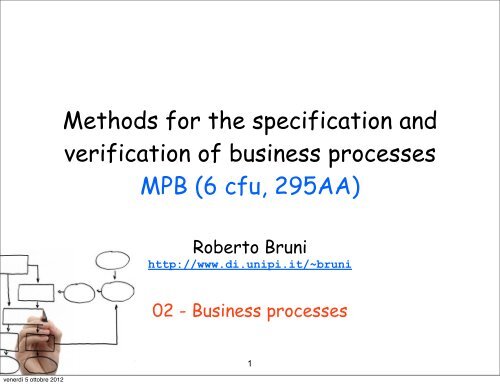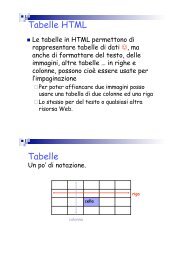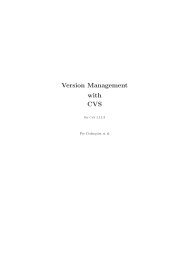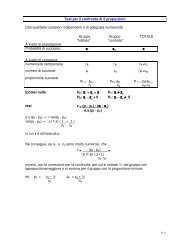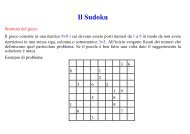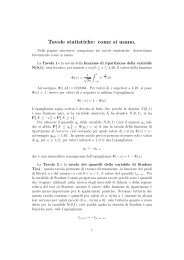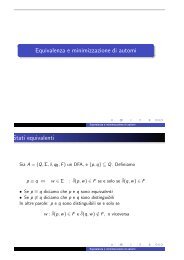Methods for the specification and verification of business processes ...
Methods for the specification and verification of business processes ...
Methods for the specification and verification of business processes ...
Create successful ePaper yourself
Turn your PDF publications into a flip-book with our unique Google optimized e-Paper software.
<strong>Methods</strong> <strong>for</strong> <strong>the</strong> <strong>specification</strong> <strong>and</strong><strong>verification</strong> <strong>of</strong> <strong>business</strong> <strong>processes</strong>MPB (6 cfu, 295AA)Roberto Brunihttp://www.di.unipi.it/~bruni02 - Business <strong>processes</strong>venerdì 5 ottobre 20121
ClassesWednesday 16:00-18:00 Room N1Friday 11:00-13:00 Room L1Today:Ch.1 <strong>of</strong> Workflow Management: Models, <strong>Methods</strong>, <strong>and</strong> SystemsCh.1 <strong>of</strong> Business Process Management: Concepts, Languages, Architecturesvenerdì 5 ottobre 20122
Digression...Exercises: find Eulerian circuits in <strong>the</strong> graphs above orprove that <strong>the</strong>y cannot exist.3venerdì 5 ottobre 2012
Digression...oddExercises: find Eulerian circuits in <strong>the</strong> graphs above orprove that <strong>the</strong>y cannot exist.3venerdì 5 ottobre 2012
Digression...oddoddExercises: find Eulerian circuits in <strong>the</strong> graphs above orprove that <strong>the</strong>y cannot exist.3venerdì 5 ottobre 2012
Digression...oddoddExercises: find Eulerian circuits in <strong>the</strong> graphs above orprove that <strong>the</strong>y cannot exist.3venerdì 5 ottobre 2012
Digression...oddoddoddExercises: find Eulerian circuits in <strong>the</strong> graphs above orprove that <strong>the</strong>y cannot exist.3venerdì 5 ottobre 2012
Digression...oddoddodd oddExercises: find Eulerian circuits in <strong>the</strong> graphs above orprove that <strong>the</strong>y cannot exist.3venerdì 5 ottobre 2012
Digression...oddoddodd oddoddExercises: find Eulerian circuits in <strong>the</strong> graphs above orprove that <strong>the</strong>y cannot exist.3venerdì 5 ottobre 2012
Digression...oddoddodd oddodd oddExercises: find Eulerian circuits in <strong>the</strong> graphs above orprove that <strong>the</strong>y cannot exist.3venerdì 5 ottobre 2012
Digression...oddoddodd oddodd oddExercises: find Eulerian circuits in <strong>the</strong> graphs above orprove that <strong>the</strong>y cannot exist.3venerdì 5 ottobre 2012
Digression...oddoddodd oddodd oddoddExercises: find Eulerian circuits in <strong>the</strong> graphs above orprove that <strong>the</strong>y cannot exist.3venerdì 5 ottobre 2012
Digression...oddoddodd oddodd oddodd oddExercises: find Eulerian circuits in <strong>the</strong> graphs above orprove that <strong>the</strong>y cannot exist.3venerdì 5 ottobre 2012
Digression...oddoddodd oddodd oddodd oddExercises: find Eulerian circuits in <strong>the</strong> graphs above orprove that <strong>the</strong>y cannot exist.3venerdì 5 ottobre 2012
Digression...oddoddodd oddodd oddodd oddoddExercises: find Eulerian circuits in <strong>the</strong> graphs above orprove that <strong>the</strong>y cannot exist.3venerdì 5 ottobre 2012
Digression...oddoddodd oddodd oddodd oddoddoddExercises: find Eulerian circuits in <strong>the</strong> graphs above orprove that <strong>the</strong>y cannot exist.3venerdì 5 ottobre 2012
Digression...oddoddodd oddodd oddodd oddoddoddoddExercises: find Eulerian circuits in <strong>the</strong> graphs above orprove that <strong>the</strong>y cannot exist.3venerdì 5 ottobre 2012
Digression...oddoddodd oddodd oddodd oddoddoddoddoddExercises: find Eulerian circuits in <strong>the</strong> graphs above orprove that <strong>the</strong>y cannot exist.3venerdì 5 ottobre 2012
Reference frameworkFix <strong>the</strong> <strong>business</strong> management contextModel <strong>and</strong> analyze <strong>processes</strong>Functionality <strong>of</strong> <strong>processes</strong> management systemsvenerdì 5 ottobre 20124
TerminologyGeneric terms, widely applicable to differentworking situations <strong>and</strong> companiesWe fix preferred terms when possible, but allowone to use synonyms interchangeably5venerdì 5 ottobre 2012
IssuesRole <strong>of</strong> work in <strong>the</strong> societyProcesses <strong>and</strong> distribution <strong>of</strong> workPrincipal-contractor relationshipOrganizational structuresProcess management6venerdì 5 ottobre 2012
WorkPeople work to live(or live to work?)We need products to maintain our lives(food, clothing, house, transportation, fun, health)We are not capable to produce all we need(or all we want, or all we are induced to want)because we cannot be skilled enoughWe buy products we cannot make ourselvesvenerdì 5 ottobre 20127
Business unitsPeople organize specialized <strong>business</strong> units(limited range <strong>of</strong> products, highly efficient)8venerdì 5 ottobre 2012
MarketProducts are supplied to people via markets(distribution in exchange <strong>of</strong> money)9venerdì 5 ottobre 2012
New servicesO<strong>the</strong>r work emerge, that would not exist(trading, banks, advertising, transportation,regulations, insurance companies)There are services <strong>and</strong> products necessary tokeep <strong>the</strong> organization operating(not making a direct contribution to keep us alive)venerdì 5 ottobre 201210
ComplexityModern society is too complex <strong>for</strong> people to seehow <strong>the</strong>ir work fits in <strong>the</strong> overall scheme(alienation can become a major social problem)The same scheme applies to large companies:high degree <strong>of</strong> work specializationcause big picture be lost by employees(why <strong>the</strong>y have to do <strong>the</strong> things <strong>the</strong>y are told to do)venerdì 5 ottobre 201211
Paradigm shiftAlienation from work can have negative effects onproductivityCompanies can allow employees to know <strong>the</strong>y are working<strong>for</strong> a particular customer(increase motivation, self-esteem, productivity)Shift:from supply-driven economy (scarce means <strong>of</strong> production)to dem<strong>and</strong>-driven economy (customers are scarce)venerdì 5 ottobre 201212
Organizational paradigmshiftvenerdì 5 ottobre 201213
IssuesRole <strong>of</strong> work in <strong>the</strong> societyProcesses <strong>and</strong> distribution <strong>of</strong> workPrincipal-contractor relationshipOrganizational structuresProcess management14venerdì 5 ottobre 2012
CaseMany different types <strong>of</strong> work exist(baking bread, making <strong>for</strong>niture, design a building,collect surveys to compile a statistic)They have in common <strong>the</strong> case:one tangible thing produced or modified(bread, <strong>for</strong>niture, house, diagram)more abstract cases are also possible(a lawsuit, an insurance claim)Synonyms: work, job, product, service, itemvenerdì 5 ottobre 201215
ProcedureWorking on a case is typically discrete in natureEvery case has a beginning <strong>and</strong> an endEach case can be distinguished from any o<strong>the</strong>r caseEach case involves a procedure being per<strong>for</strong>med:<strong>the</strong> tasks to be carried out <strong>and</strong> <strong>the</strong> conditions thatdetermine <strong>the</strong> order <strong>of</strong> <strong>the</strong> tasksvenerdì 5 ottobre 2012Synonyms: process, project16
TaskA task is a logical unit <strong>of</strong> work that is carried out as asingle wholevenerdì 5 ottobre 201217
KnowledgeSome tasks can be per<strong>for</strong>med by a computer withouthuman interventionExecuting some tasks may require humanintelligence: a judgement or a decision(a bank employee decides about a loan request)Persons need knowledge to execute tasks(<strong>the</strong>ir past experience, company guidelines)venerdì 5 ottobre 201218
ResourceA resource is <strong>the</strong> generic name <strong>for</strong> a person,machine or group <strong>of</strong> persons or machines that isresponsible <strong>for</strong> a task19venerdì 5 ottobre 2012
ActivityAn activity is <strong>the</strong> per<strong>for</strong>mance <strong>of</strong> a task by aresourceVarious cases may share <strong>the</strong> same procedure, buteach case may involve different activities to becarried out, depending on case attributes(one insurance claim may involve objections <strong>and</strong>ano<strong>the</strong>r one may not)venerdì 5 ottobre 201220
Cases vs proceduresThe number <strong>of</strong> procedures in a company is(generally) finite <strong>and</strong> far smaller than <strong>the</strong> number <strong>of</strong>cases to be h<strong>and</strong>ledExample: it is easier to make one hundred skirtswith <strong>the</strong> same pattern than one hundred skirts usingdifferent patternsExample: <strong>of</strong>f-<strong>the</strong>-rack is cheaper than made-tomeasurevenerdì 5 ottobre 201221
Economy <strong>of</strong> scaleThe cost per case fall as <strong>the</strong> number <strong>of</strong> casesincreasesStrategy: keep <strong>the</strong> number <strong>of</strong> procedures small <strong>and</strong>make <strong>the</strong> number <strong>of</strong> cases that each can per<strong>for</strong>m ashigh as possiblePr<strong>of</strong>it, after all, is <strong>the</strong> ultimate objective(not necessarily <strong>the</strong> best one)venerdì 5 ottobre 201222
ExampleInsurance companies want to keep <strong>the</strong> number <strong>of</strong>claims as low as possible, but this is generally afactor <strong>the</strong>y cannot controlThey can try to keep low <strong>the</strong> number <strong>of</strong> procedures,but <strong>the</strong> risk is to make <strong>the</strong>m too much complex(a unique procedure to h<strong>and</strong>le all cases is possiblein principle, but inefficient in practice)Ideal situation: a small number <strong>of</strong> good procedures,with a lot <strong>of</strong> cases to be h<strong>and</strong>led by each <strong>of</strong> <strong>the</strong>mvenerdì 5 ottobre 201223
Different examplesWhat about tailor-made suits?one case per process?What about architects <strong>and</strong> houses?design from scratch <strong>for</strong> each case?24venerdì 5 ottobre 2012
Not so different?Tailors <strong>and</strong> architects can exploit st<strong>and</strong>ardapproaches <strong>for</strong> each caseTailor process: take customer’s measurement, showa number <strong>of</strong> patterns, modify <strong>the</strong> chosen pattern,choose <strong>the</strong> fabric, draw <strong>the</strong> patternObservation: tasks can be highly dependent oncasesvenerdì 5 ottobre 201225
One-<strong>of</strong>-a-kind <strong>processes</strong>The first stage in tackling <strong>the</strong> case is <strong>the</strong>design <strong>of</strong> its specific processEven in this case, st<strong>and</strong>ard tasks can befrequently found that are used to compile manyspecific <strong>processes</strong>venerdì 5 ottobre 201226
IssuesRole <strong>of</strong> work in <strong>the</strong> societyProcesses <strong>and</strong> distribution <strong>of</strong> workPrincipal-contractor relationshipOrganizational structuresProcess management27venerdì 5 ottobre 2012
PrincipalMost people’s work is assigned or outsourced to<strong>the</strong>m by o<strong>the</strong>r people: <strong>the</strong>ir principals(<strong>the</strong>y can be company departments or firms)We can divide principals in two <strong>for</strong>ms:boss <strong>and</strong> customerAssignments ordered by bosses are related towork <strong>for</strong> customers(directly in case <strong>of</strong> production process,indirectly <strong>for</strong> support <strong>and</strong> managerial <strong>processes</strong>)venerdì 5 ottobre 201228
ActorsA person who is assigned a task is calledcontractor, or also resource(assignments can be carried out by machines<strong>and</strong> computer applications as well as by people)An actor can be a principal or a contractor, orplay both roles at <strong>the</strong> same time(contractors may redirect work to third parties)venerdì 5 ottobre 201229
ContractA contract exists between a principal <strong>and</strong> acontractor about <strong>the</strong> case to be per<strong>for</strong>med(deadline <strong>for</strong> completion, price to be paid)A communication protocol can be establishedbetween a principal <strong>and</strong> a contractorto exchange in<strong>for</strong>mationvenerdì 5 ottobre 201230
Protocol examplePrincipalContractor<strong>specification</strong>quoteassignmentconfirmationordercompletion31venerdì 5 ottobre 2012
Contract tree exampletransport from A to ZPrincipaltransport from A to Qtransport from Q to ZContractorPrincipalContractortransport from A to Dtransport from D to QContractorContractor32venerdì 5 ottobre 2012
IssuesRole <strong>of</strong> work in <strong>the</strong> societyProcesses <strong>and</strong> distribution <strong>of</strong> workPrincipal-contractor relationshipOrganizational structuresProcess management33venerdì 5 ottobre 2012
venerdì 5 ottobre 201234
OrganizationalstructureAn organizational structure establishes how<strong>the</strong> work, authorities <strong>and</strong> responsibilities aredivided up amongst its staff(roles <strong>and</strong> functions)A single person can fulfill several roles, toge<strong>the</strong>ror along timevenerdì 5 ottobre 201235
Most relevant <strong>for</strong>ms o<strong>for</strong>ganizational structureHierarchical: structured as a tree, internalnodes are individual roles or functions, leavesare staff or departments, branches are authorityrelationships (independent <strong>of</strong> cases)Matrix: add (dynamic) functional dimension(each person can have one or more functionalbosses, known as project leaders)venerdì 5 ottobre 2012Network: autonomous actors collaborate tosupply products or services36
IssuesRole <strong>of</strong> work in <strong>the</strong> societyProcesses <strong>and</strong> distribution <strong>of</strong> workPrincipal-contractor relationshipOrganizational structuresProcess management37venerdì 5 ottobre 2012
What is all aboutEach product that a companyprovides to <strong>the</strong> marketis <strong>the</strong> outcome <strong>of</strong> a number<strong>of</strong> activities per<strong>for</strong>medBusiness <strong>processes</strong> are aboutactivities underst<strong>and</strong>ing,correlation, organization<strong>and</strong> improvement38venerdì 5 ottobre 2012
AwarenessProcess management systems support <strong>and</strong>encourage communication between employees<strong>and</strong> make <strong>the</strong>ir activities more controllable39venerdì 5 ottobre 2012
Narrowing <strong>the</strong> gapOrganizational <strong>business</strong> aspectsvenerdì 5 ottobre 201240In<strong>for</strong>mation technology
EnactmentActivities can be per<strong>for</strong>med by employeesmanually or by <strong>the</strong> help <strong>of</strong> in<strong>for</strong>mation systemsO<strong>the</strong>r activities can be enactedautomatically by in<strong>for</strong>mation systemsSome activities can triggeror inhibit o<strong>the</strong>r activities41venerdì 5 ottobre 2012
Process orientationroots (1990’s)Seminal book advocating<strong>the</strong> radical redesign <strong>of</strong> <strong>the</strong> <strong>business</strong>process <strong>of</strong> a company as opposedto evolutionary improvementsA <strong>business</strong> process is a collection <strong>of</strong> activitiesthat take one or more kinds <strong>of</strong> input <strong>and</strong>create an output that is <strong>of</strong> value to <strong>the</strong> customer- Hammer & Champy (1993)venerdì 5 ottobre 201242
KeywordsHammer & Champy: collection, input, outputvenerdì 5 ottobre 201243
How vs WhatThe main innovation is <strong>the</strong> shift <strong>of</strong> focus on <strong>the</strong><strong>business</strong> logic <strong>of</strong> <strong>the</strong> process (how work is done),instead <strong>of</strong> <strong>the</strong> product perspective (what is done)venerdì 5 ottobre 201244
Process orientationroots (1990’s)The trans<strong>for</strong>mation that occurs in <strong>the</strong> processshould add value to <strong>the</strong> input <strong>and</strong> create anoutput that is more useful <strong>and</strong> effective to <strong>the</strong>recipient ei<strong>the</strong>r upstream or downstreamA process is a set <strong>of</strong> linked activities that take an input<strong>and</strong> trans<strong>for</strong>m it to create an output.- Johansson et al. (1993)venerdì 5 ottobre 201245
KeywordsHammer & Champy: collection, input, outputJohansson et al.: upstream, downstream, linkedvenerdì 5 ottobre 201246
Process orientationroots (1990’s)Processes as structured, measured sets<strong>of</strong> activities designed to produce aspecific output <strong>for</strong> a particular marketA process is a specific ordering <strong>of</strong> work activities acrosstime <strong>and</strong> space, with a beginning <strong>and</strong> an end, <strong>and</strong>clearly defined inputs <strong>and</strong> outputs: a structure <strong>for</strong> action.- Davenport (1993)venerdì 5 ottobre 201247
KeywordsHammer & Champy: collection, input, outputJohansson et al.: upstream, downstream, linkedDavenport: structure, ordering, time, space, begin, endvenerdì 5 ottobre 201248
More from DavenportUnless designers or participants can agree on <strong>the</strong>way work is <strong>and</strong> should be structured, it will bevery difficult to systematically improve, or effectinnovation in, that workWhereas an organization’s hierarchical structure istypically a slice-in-time view <strong>of</strong> responsibilities <strong>and</strong>reporting relationships, its process structure is adynamic view <strong>of</strong> how <strong>the</strong> organization deliversvaluevenerdì 5 ottobre 201249
More from DavenportFur<strong>the</strong>rmore, while we cannot measure or improvehierarchical structure in any absolute sense,<strong>processes</strong> that are clearly structured are amenableto measurement in a variety <strong>of</strong> dimensions havecost, time, output quality, <strong>and</strong> customer satisfactionWhen we reduce cost or increase customersatisfaction, we have bettered <strong>the</strong> process itselfvenerdì 5 ottobre 201250
More from DavenportProcesses also need clearly defined owners to beresponsible <strong>for</strong> design <strong>and</strong> execution.Process ownership must be seen as an additional oralternative dimension <strong>of</strong> <strong>the</strong> <strong>for</strong>mal organizationalstructure that, during periods <strong>of</strong> radical processchange, takes precedence over o<strong>the</strong>r dimensions<strong>of</strong> structure.O<strong>the</strong>rwise process owners will not have <strong>the</strong> poweror legitimacy needed to implement process designsthat violate organizational charts <strong>and</strong> normsvenerdì 5 ottobre 201251
KeywordsHammer & Champy: collection, input, outputJohansson et al.: upstream, downstream, linkedDavenport: structure, ordering, time, space, begin,end, dynamic, measurement, ownervenerdì 5 ottobre 201252
More from DavenportIn service industries it is nearly impossible todistinguish between innovative new services<strong>of</strong>fered to <strong>the</strong> customers <strong>and</strong> <strong>the</strong> innovative<strong>processes</strong> that enable <strong>the</strong>mFollowing a structured process is generally a goodthing, <strong>and</strong> <strong>the</strong>re is nothing inherently slow orinefficient about acting along process linesvenerdì 5 ottobre 201253
Process orientationroots (1990’s)Most <strong>processes</strong> are cross-functional,spanning <strong>the</strong> ‘white space’ between <strong>the</strong> boxeson <strong>the</strong> organization chart. Some <strong>processes</strong>result in a product or service that is received byan organization's external customer.We call <strong>the</strong>se production <strong>processes</strong>.O<strong>the</strong>r <strong>processes</strong> produce products that are invisible to <strong>the</strong>external customer but essential to <strong>the</strong> effectivemanagement <strong>of</strong> <strong>the</strong> <strong>business</strong>.We call <strong>the</strong>se support <strong>processes</strong>venerdì 5 ottobre 201254- Rummler & Brache (1995)
General applicabilityThe approach can be applied to both large <strong>and</strong>small <strong>processes</strong>: to <strong>the</strong> entire set <strong>of</strong> activities thatserves customers, or only to answering a letter <strong>of</strong>complaint.The larger <strong>the</strong> process, however, <strong>the</strong> greater <strong>the</strong>potential <strong>for</strong> radical benefitKey generic <strong>business</strong> <strong>processes</strong> include productdevelopment, customer order fulfillment, <strong>and</strong>financial asset managementvenerdì 5 ottobre 201255
Typical <strong>processes</strong> inmanufacturing firmsOperational: product development, customeracquisition, customer requirements identification,manufacturing, integrated logistics, ordermanagement, post-sales serviceManagement: per<strong>for</strong>mance monitoring, in<strong>for</strong>mationmanagement, asset management, human resourcemanagement, planning <strong>and</strong> resource allocationvenerdì 5 ottobre 201256
Primary processProduce company’s products(production <strong>processes</strong>)Customer-oriented, even if sometimes <strong>the</strong>customer is not known in advanceGenerate income <strong>for</strong> <strong>the</strong> companyExamples: raw materials purchase, service sale,design <strong>and</strong> engineering, distribution57venerdì 5 ottobre 2012
Secondary processSupport primary <strong>processes</strong>(support <strong>processes</strong>)Examples: machinery purchase <strong>and</strong> maintenance,personnel management (recruitment <strong>and</strong> selection,training, work appraisal, payrolls, dismissal),financial administration, marketingvenerdì 5 ottobre 201258
Tertiary processDirect <strong>and</strong> coordinate primary <strong>and</strong> secondary ones(managerial <strong>processes</strong>)Fix objectives, allocated resources <strong>and</strong>preconditions <strong>for</strong> <strong>the</strong> managers <strong>of</strong> o<strong>the</strong>r <strong>processes</strong>Examples: maintenance <strong>of</strong> contracts withfinanciers <strong>and</strong> o<strong>the</strong>r stakeholdersvenerdì 5 ottobre 201259
1, 2, 3orders,components,raw materialsproductionproducts,services60venerdì 5 ottobre 2012
1, 2, 3orders,components,raw materialsproductionproducts,servicesreturnresourcesafter useprovideresourcessupport60venerdì 5 ottobre 2012
1, 2, 3orders,components,raw materialsproductionproducts,servicesreturnresourcesafter useprovideresourcessupportresourcesdisposal <strong>of</strong>resources60venerdì 5 ottobre 2012
1, 2, 3orders,components,raw materialsproductionproducts,servicesreturnresourcesafter usesupportresourcesprovideresourcesincome reportsmeans to buyresourcesmanagerialdisposal <strong>of</strong>resources60venerdì 5 ottobre 2012
1, 2, 3orders,components,raw materialsproductionproducts,servicesreturnresourcesafter useprovideresourcesassignments,purchasing budgetsincome reportssupportresourcesincome reportsmeans to buyresourcesmanagerialdisposal <strong>of</strong>resources60venerdì 5 ottobre 2012
1, 2, 3orders,components,raw materialsproductionproducts,servicesreturnresourcesafter useprovideresourcesassignments,purchasing budgetsincome reportssupportresourcesincome reportsmeans to buyresourcesmanagerialobjectives,capitaldisposal <strong>of</strong>resources60per<strong>for</strong>mance,pr<strong>of</strong>itvenerdì 5 ottobre 2012
KeywordsHammer & Champy: collection, input, outputJohansson et al.: upstream, downstream, linkedDavenport: structure, ordering, time, space, begin,end, dynamic, measurement, ownerRummler & Brache: production, support, managerialvenerdì 5 ottobre 201261
Summing up62venerdì 5 ottobre 2012
DefinabilityProcesses must have clearly defined boundaries,input <strong>and</strong> outputvenerdì 5 ottobre 201263
StructuredProcesses wrap up a collection <strong>of</strong> tasks64venerdì 5 ottobre 2012
OrderedProcess tasks are ordered according to <strong>the</strong>irposition in time <strong>and</strong> space65venerdì 5 ottobre 2012
DigressionWhat is a partial order?(S, ⊑)66venerdì 5 ottobre 2012
DigressionWhat is a partial order?(S, ⊑)S is a set66venerdì 5 ottobre 2012
DigressionWhat is a partial order?(S, ⊑)S is a set⊑ is a binary relation included in S × S66venerdì 5 ottobre 2012
DigressionWhat is a partial order?(S, ⊑)S is a set⊑ is a binary relation included in S × S⊑ is reflexive66venerdì 5 ottobre 2012
DigressionWhat is a partial order?(S, ⊑)S is a set⊑ is a binary relation included in S × S⊑ is reflexive∀x ∈ S we have x ⊑ x66venerdì 5 ottobre 2012
DigressionWhat is a partial order?(S, ⊑)S is a set⊑ is a binary relation included in S × S⊑ is reflexive∀x ∈ S we have x ⊑ x⊑ is transitive66venerdì 5 ottobre 2012
DigressionWhat is a partial order?(S, ⊑)S is a set⊑ is a binary relation included in S × S⊑ is reflexive∀x ∈ S we have x ⊑ x⊑ is transitive∀x, y, z ∈ S, if x ⊑ y <strong>and</strong> y ⊑ z, <strong>the</strong>n x ⊑ z66venerdì 5 ottobre 2012
DigressionWhat is a partial order?(S, ⊑)S is a set⊑ is a binary relation included in S × S⊑ is reflexive∀x ∈ S we have x ⊑ x⊑ is transitive∀x, y, z ∈ S, if x ⊑ y <strong>and</strong> y ⊑ z, <strong>the</strong>n x ⊑ z⊑ is anti-symmetric66venerdì 5 ottobre 2012
DigressionWhat is a partial order?(S, ⊑)S is a set⊑ is a binary relation included in S × S⊑ is reflexive∀x ∈ S we have x ⊑ x⊑ is transitive∀x, y, z ∈ S, if x ⊑ y <strong>and</strong> y ⊑ z, <strong>the</strong>n x ⊑ z⊑ is anti-symmetric∀x, y ∈ S, if x ⊑ y <strong>and</strong> y ⊑ x, <strong>the</strong>n x = y66venerdì 5 ottobre 2012
DigressionWhat is a total order?67venerdì 5 ottobre 2012
DigressionWhat is a total order?(S, ⊑) is a partial order <strong>and</strong>venerdì 5 ottobre 201267
DigressionWhat is a total order?(S, ⊑) is a partial order <strong>and</strong>∀x, y ∈ S we have x ⊑ y or y ⊑ xvenerdì 5 ottobre 201267
ExercisesAre <strong>the</strong> following pairs partial / total orders?(Nat,
ExercisesAre <strong>the</strong> following pairs partial / total orders?(Nat,
ExercisesAre <strong>the</strong> following pairs partial / total orders?(Nat,
ExercisesAre <strong>the</strong> following pairs partial / total orders?(Nat,
ExercisesAre <strong>the</strong> following pairs partial / total orders?(Nat,
ExercisesAre <strong>the</strong> following pairs partial / total orders?(Nat,
ExercisesAre <strong>the</strong> following pairs partial / total orders?(Nat,
DigressionWhat is a linear extension <strong>of</strong> a partial order?69venerdì 5 ottobre 2012
DigressionWhat is a linear extension <strong>of</strong> a partial order?Let (S, ⊑) be a partial order <strong>and</strong> (S, ≼) a total ordervenerdì 5 ottobre 201269
DigressionWhat is a linear extension <strong>of</strong> a partial order?Let (S, ⊑) be a partial order <strong>and</strong> (S, ≼) a total order(S, ≼) is a linear extension <strong>of</strong> (S, ⊑) ifvenerdì 5 ottobre 201269
DigressionWhat is a linear extension <strong>of</strong> a partial order?Let (S, ⊑) be a partial order <strong>and</strong> (S, ≼) a total order(S, ≼) is a linear extension <strong>of</strong> (S, ⊑) if∀x, y ∈ S we have that x ⊑ y implies x ≼ yvenerdì 5 ottobre 201269
DigressionWhat is a linear extension <strong>of</strong> a partial order?Let (S, ⊑) be a partial order <strong>and</strong> (S, ≼) a total order(S, ≼) is a linear extension <strong>of</strong> (S, ⊑) if∀x, y ∈ S we have that x ⊑ y implies x ≼ y(or equivalently, ⊑ is included in ≼)venerdì 5 ottobre 201269
ExercisesS = {a, b, c, d, e, f}a ⊑ b ⊑ d ⊑ f a ⊑ c ⊑ e ⊑ f c ⊑ dWhich <strong>of</strong> <strong>the</strong> following are linear extensions?(we write, e.g., abc <strong>for</strong> a ≼ b ≼ c)70venerdì 5 ottobre 2012
ExercisesS = {a, b, c, d, e, f}a ⊑ b ⊑ d ⊑ f a ⊑ c ⊑ e ⊑ f c ⊑ dWhich <strong>of</strong> <strong>the</strong> following are linear extensions?(we write, e.g., abc <strong>for</strong> a ≼ b ≼ c)abcdef70venerdì 5 ottobre 2012
ExercisesS = {a, b, c, d, e, f}a ⊑ b ⊑ d ⊑ f a ⊑ c ⊑ e ⊑ f c ⊑ dWhich <strong>of</strong> <strong>the</strong> following are linear extensions?(we write, e.g., abc <strong>for</strong> a ≼ b ≼ c)abcdefacbedf70venerdì 5 ottobre 2012
ExercisesS = {a, b, c, d, e, f}a ⊑ b ⊑ d ⊑ f a ⊑ c ⊑ e ⊑ f c ⊑ dWhich <strong>of</strong> <strong>the</strong> following are linear extensions?(we write, e.g., abc <strong>for</strong> a ≼ b ≼ c)abcdefabcedfacbedf70venerdì 5 ottobre 2012
ExercisesS = {a, b, c, d, e, f}a ⊑ b ⊑ d ⊑ f a ⊑ c ⊑ e ⊑ f c ⊑ dWhich <strong>of</strong> <strong>the</strong> following are linear extensions?(we write, e.g., abc <strong>for</strong> a ≼ b ≼ c)abcdefabcedfacebdfacbedf70venerdì 5 ottobre 2012
ExercisesS = {a, b, c, d, e, f}a ⊑ b ⊑ d ⊑ f a ⊑ c ⊑ e ⊑ f c ⊑ dWhich <strong>of</strong> <strong>the</strong> following are linear extensions?(we write, e.g., abc <strong>for</strong> a ≼ b ≼ c)abcdefabcedfacebdfacbedfacefbd70venerdì 5 ottobre 2012
ExercisesS = {a, b, c, d, e, f}a ⊑ b ⊑ d ⊑ f a ⊑ c ⊑ e ⊑ f c ⊑ dWhich <strong>of</strong> <strong>the</strong> following are linear extensions?(we write, e.g., abc <strong>for</strong> a ≼ b ≼ c)abcdefabcedfabdcefacebdfacbedfacefbd70venerdì 5 ottobre 2012
LinkedProcess activities are linked along a value-addedchainvenerdì 5 ottobre 201271 59 58
CustomerThe process output has a recipient72venerdì 5 ottobre 2012
MeasurabilityThe process output can be evaluated73venerdì 5 ottobre 2012
OwnershipThere is one responsible <strong>for</strong> <strong>the</strong> per<strong>for</strong>mance <strong>and</strong>continuous improvement <strong>of</strong> <strong>the</strong> processvenerdì 5 ottobre 201274
Cross-functionalityA process can span several functions within <strong>and</strong>across <strong>the</strong> organizational structure in which it isembedded75venerdì 5 ottobre 2012
Some definitions76venerdì 5 ottobre 2012
Business processDefinition: a <strong>business</strong> process consists <strong>of</strong> a set<strong>of</strong> activities that are per<strong>for</strong>med in coordination in anorganizational <strong>and</strong> technical environment.These activities jointly realize a <strong>business</strong> goal.Each <strong>business</strong> process is enacted by a singleorganization, but it may interact with <strong>business</strong><strong>processes</strong> per<strong>for</strong>med by o<strong>the</strong>r organizations.- Weskevenerdì 5 ottobre 201277
Business processmanagementDefinition: <strong>business</strong> process managementincludes concepts, methods, <strong>and</strong> techniques tosupport <strong>the</strong> design, administration, configuration,enactment, <strong>and</strong> analysis <strong>of</strong> <strong>business</strong> <strong>processes</strong>.- Weskevenerdì 5 ottobre 201278
Business processmanagementThe basis <strong>of</strong> <strong>business</strong> process management is <strong>the</strong>explicit representation <strong>of</strong> <strong>business</strong> <strong>processes</strong> with<strong>the</strong>ir activities <strong>and</strong> <strong>the</strong> execution constraintsbetween <strong>the</strong>mBusiness <strong>processes</strong> can <strong>the</strong>n be subject toanalysis, improvement, <strong>and</strong> enactmentvenerdì 5 ottobre 201279
Business processmanagement systemDefinition: <strong>business</strong> process managementsystem is a generic s<strong>of</strong>tware system that is drivenby explicit process representations to coordinate<strong>the</strong> enactment <strong>of</strong> <strong>business</strong> <strong>processes</strong>.- Weskevenerdì 5 ottobre 201280
Business process modelDefinition: <strong>business</strong> process model consists <strong>of</strong> aset <strong>of</strong> activity models <strong>and</strong> execution constraintsbetween <strong>the</strong>m.- Weskevenerdì 5 ottobre 201281
Business processinstanceDefinition: <strong>business</strong> process instancerepresents a concrete case in <strong>the</strong> operational<strong>business</strong> <strong>of</strong> a company, consisting <strong>of</strong> activityinstances.- Weskevenerdì 5 ottobre 201282
Model <strong>and</strong> instancesEach <strong>business</strong> process model acts as a blueprint<strong>for</strong> a set <strong>of</strong> <strong>business</strong> process instancesEach activity model acts as a blueprint <strong>for</strong> a set <strong>of</strong>activity instancesvenerdì 5 ottobre 201283
Model <strong>and</strong> instancesEach <strong>business</strong> process model acts as a blueprint<strong>for</strong> a set <strong>of</strong> <strong>business</strong> process instancesEach activity model acts as a blueprint <strong>for</strong> a set <strong>of</strong>activity instancesvenerdì 5 ottobre 201283
Abuse <strong>of</strong> notationIf no confusion is possible, <strong>the</strong> term <strong>business</strong>process is used to refer to ei<strong>the</strong>r <strong>business</strong> processmodels or <strong>business</strong> process instancesAnalogously, <strong>the</strong> term activity is used to refer toei<strong>the</strong>r activity models or activity instancesvenerdì 5 ottobre 201284
Process-drivens<strong>of</strong>twareBusiness process models are <strong>the</strong> main artefact <strong>for</strong>implementing <strong>business</strong> <strong>processes</strong>This implementation can be done by organizationalrules <strong>and</strong> policies, but it can also be done by<strong>business</strong> process management (s<strong>of</strong>tware) systemIn this case <strong>the</strong> s<strong>of</strong>tware system is driven byexplicit process representationsvenerdì 5 ottobre 201285
Process representationsVisual representations: diagrams <strong>and</strong> charts(few conventions, intuitive)Languages: precise syntax(process dialects, XML)Models: precise semantics(Petri nets, YAWL)venerdì 5 ottobre 201286


